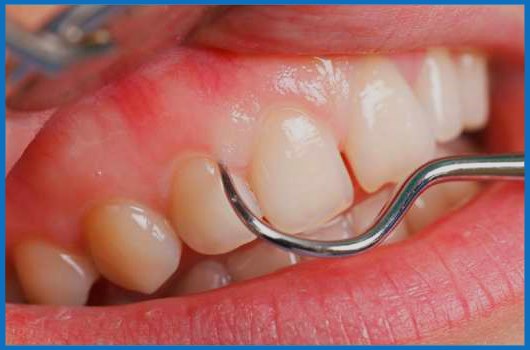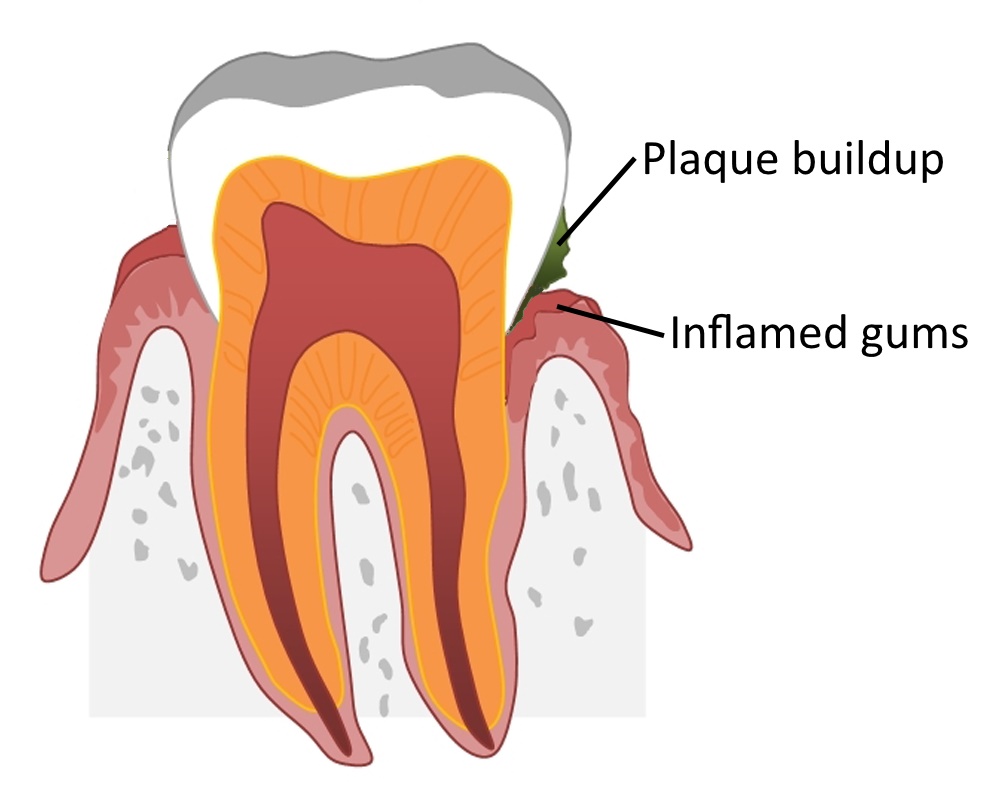Can Gum Disease Be Reversed?

If your dentist or dental hygienist has cautioned you about gum problems, your most immediate concern is likely whether gum disease can be reversed once you have it. The good news is, if caught at an early stage, it can indeed be reversible!
When talking about gum disease, it is worth distinguishing between mild gum disease (gingivitis) and more severe gum disease (periodontitis). The chances of reversing gum disease are much greater from its mild state than from its severe state.
5 Steps To Reverse Gum Disease at the Gingivitis Stage

Gingivitis is caused by plaque and tartar buildup
Gum disease is usually caused by dental plaque buildup. To reverse gum disease, remove those food remains, and prevent new buildup. Here are are tips:
- Floss. If you don’t already floss on a daily basis, then this is your number #1 best solution to fight gum disease. Your gums will bleed, and there will be blood on your floss, but that’s fine. It’s more important to get rid of the bacteria and food remains. We recommend using Oral B Superfloss. It has a hardened pointy end, making it easy to manoeuvre the softer thread in the right place.
- If you cannot floss for whatever reason, then use a waterflosser
- Obviously, brush your 2x-3x per day – especially after a meal. Use a softer tooth brush until your gums stop bleeding.
- Use mouthwash. Don’t overdo it. Once a day is enough.
- TOP TIP: for severe gum disease, apply an anti-inflammatory gel on the gums themselves. We’ve seen great results from patients with a long tradition of gum disease by temporarily applying this gel during the worst phase of their gingivitis.
It is also important to ensure that you are brushing and flossing using the correct techniques. For instance, when brushing, you should be positioning your toothbrush at a 45-degree angle to your gums, and making sure to brush all parts of all of your teeth, including inward and outward-facing sides, as well as the chewing surfaces. It is best to always use a soft-bristled toothbrush, and to replace your brush every three to four months, or more often if the bristles are wearing down sooner than this.
When flossing, you should be covering both sides of every tooth, from the base and gum line right up to the tip, for a full clean. What is good for your teeth is also good for your gums, and preventing plaque buildup before it hardens into tartar is integral to both healthy teeth and gums. If you have any doubt as to whether you’re brushing and flossing correctly, show your dentist or dental hygienist how you have been doing it at your next appointment, and they can provide you with feedback and demonstrate how you can improve.
Along with brushing and flossing, the use of antibacterial mouthwash is of significant value in helping gum disease to go away. It is important, however, to select a mouthwash that is intended for more than simply controlling bad breath. A therapeutic mouthwash helps with reversing gingivitis, whereas a cosmetic mouthwash merely reduces bad breath, but does not kill the bacteria associated with plaque development and gum damage. When selecting a mouthwash, choose one that is approved by the American Dental Association, bearing the ADA Seal of Acceptance.
In addition to proper brushing, flossing, and the use of mouthwash, your dentist or hygienist may recommend the use of particular products for your individual gum health situation, such as an electric toothbrush, a water flosser, or special brand of mouthwash. Your dentist and hygienist are your best resource for gingivitis solutions specific to your unique dental needs.
Speaking of your dentist and hygienist, another key way that gum disease can be treated and your gum health restored, is by ensuring you have regular appointments for both check-ups and teeth-cleaning. The fluoride treatment administered during a professional cleaning with your hygienist has much greater power than the fluoride in your toothpaste, and is crucial to your overall dental health. Depending on the severity of your gingivitis, your dentist or hygienist may recommend more frequent fluoride treatments to address the problem, but an application every six months is typical.
How to Reverse Gum Disease at the Periodontitis Stage
Even severe gum disease can be treated, but at this point it is more likely to require extensive intervention from dental professionals, including both dentists and periodontists. At the least invasive, this might involve the nonsurgical removal of plaque and tartar from around the gums (through the use of scaling) and the smoothing of roughness on the roots of teeth (through the use of planing).
If the periodontitis is more advanced, surgical interventions are more likely to be needed. This can include the use of bone grafts and soft tissue grafts to replace bone and gum tissue that has been damaged by gum disease, or flap surgery by which the gums are lifted away to allow for cleaning of the roots of teeth and then are stitched back into place. This latter approach may also be accompanied by bone surgery and guided tissue regeneration.
Advances in periodontitis treatment have resulted in the development of the “pinhole surgical technique” as a much less invasive alternative to gum grafting. As a general rule though, reversing gum disease early on, at the gingivitis stage, is less difficult than doing so later. Of course, preventing it entirely is the easiest of all, because when it comes to your teeth and gums, a proactive approach is always the best one!
Gingivitis: Symptoms and Implications
If you find that your gums are sensitive and bleed easily while you are brushing or flossing, and that they are red or swollen, these are particularly common indicators of gingivitis. Such symptoms may also be accompanied by bad breath and teeth that appear longer due to receding gums. If you have one or more of these symptoms, it could be indication of the presence of mild gum disease. If it is left untreated over a period of time, the result is that gingivitis can progress to the more serious complications involved with periodontitis
Periodontitis: Symptoms and Implications
If gum disease is not effectively treated in its milder and most common form of gingivitis, it can progress to periodontitis. At this point, significant pockets of air can form between the teeth and gums, as the gums further recede and deteriorate due to the continued spread of plaque below the gum line. This may ultimately result in teeth becoming loose and beginning to fall out. Periodontitis has also been associated with various major health concerns beyond the teeth and gums themselves. You may wonder, does gum disease go away even once it has progressed to the point of periodontitis?
